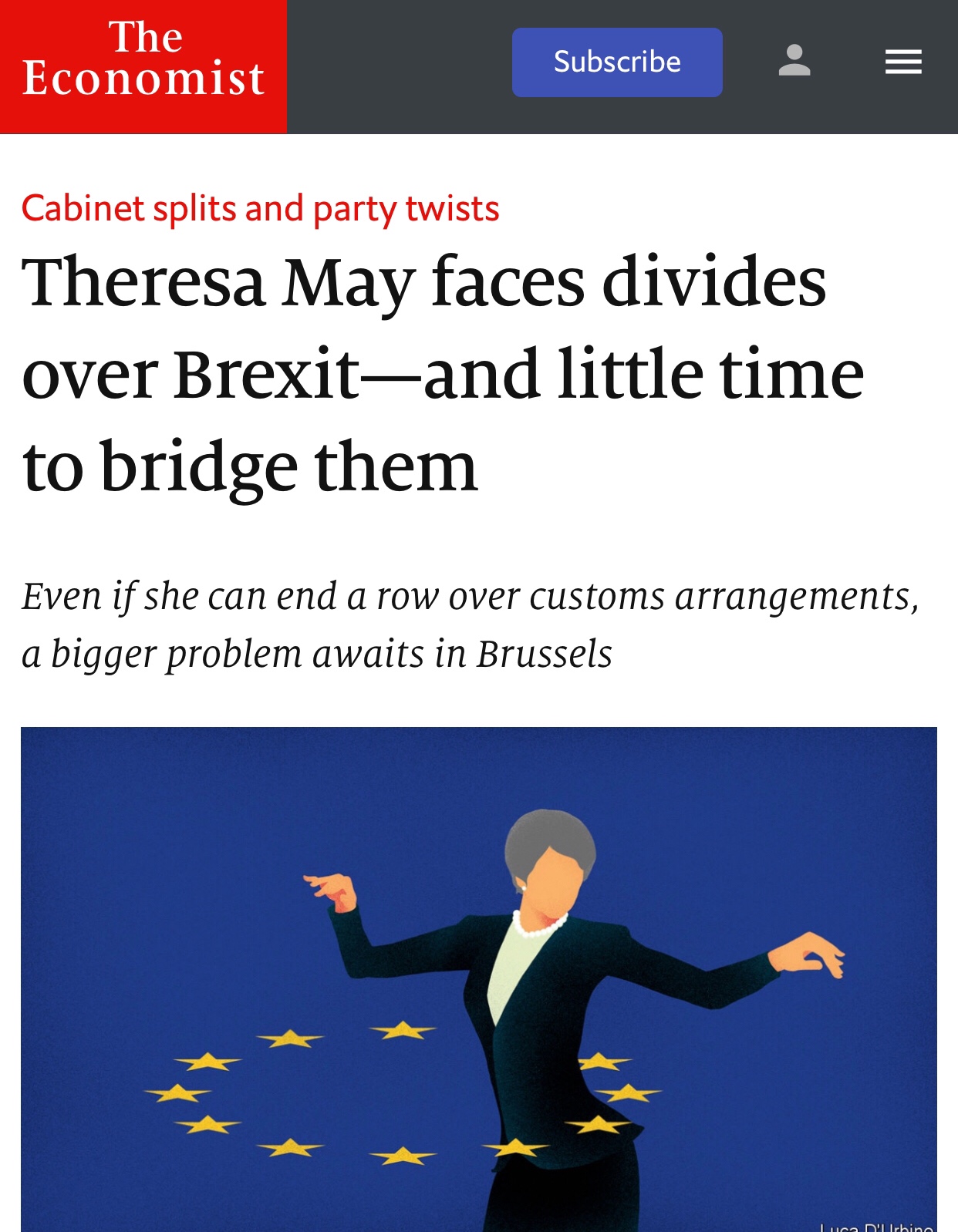Theresa May faces divides over Brexit—and little time to bridge them
The Economist writes today an article about the current situation of the Brexit preparations. According to their view. Here it is.
For the record I personally don’t agree with all statements in this article and the views expressed here. Especially in relation to what is possible or not according to international rules and regulations. Still an interesting article.
WHEN she became prime minister in July 2016, and again when she called an election last April, Theresa May hoped to unite both the country and her party. Yet almost two years after the Brexit referendum and just nine months before Britain is due to leave the European Union, the splits seem wider than ever. That is one conclusion from the latest outburst by her foreign secretary, Boris Johnson, who dubbed her preferred option for a customs partnership with the EU “crazy” and suggested it would betray the spirit of the referendum.

In truth, Mr Johnson’s intervention is part of a power play by Tory Brexiteers, notably the European Research Group of 60-odd backbenchers led by Jacob Rees-Mogg. This group insists on the hardest Brexit, with a clean break from the EU’s single market and customs union. Brexiteers want to stiffen the prime minister’s resolve to stick to the red lines she drew in her first conference speech as leader—and to keep the threat that, if the EU is obstructive, Britain will walk away with no deal.
Yet in the past year Mrs May has found that negotiation in Brussels requires give and take, and that not all her goals are compatible. She knows a no-deal exit would be horribly disruptive. She has accepted that there will be a post-Brexit transition period in which nothing much changes, and agreed to pay a hefty exit bill. She hopes to stay in many EU agencies and in regulatory alignment for much trade in goods. And she wants a customs arrangement that minimises friction and helps avoid a hard border in Northern Ireland.
Brexiteers had swallowed all this as a price for the prize they covet. In March Mr Rees-Mogg called for Mrs May to have the space and time to pursue the best Brexit deal. It even seemed that he and his allies could live with ambiguity over customs. On this, Mrs May’s red line was fuzzier than on leaving the single market. And her customs partnership, under which the government would apply EU duties to imports, but find some clever way of tracking and refunding them for goods destined only for Britain, was proposed last August and reaffirmed in March.
But suddenly the Brexiteers are rebelling. They know a majority of the cabinet’s Brexit sub-committee, which now includes Sajid Javid, who is more Eurosceptic than Amber Rudd, his predecessor as home secretary, is against the customs partnership. Instead the committee leans to a so-called maximum facilitation option, which would minimise friction by relying on new technology, trusted traders and exemptions. David Davis, the Brexit secretary, has made his preference for this clear.
One of many surreal features of the whole argument is that the EU has dismissed both customs options as unworkable. Both rely on untried technology and untested computer systems. Maximum facilitation would be an invitation to smuggling and almost certainly against World Trade Organisation rules. Moreover, neither option would avert a hard border in Northern Ireland. That would require close alignment to most single-market regulations as well.
Brexiteers fear that, because of this, Mrs May’s customs partnership would evolve into a customs union, dashing hopes of trade deals with third countries. Some even say being in such a union would be worse than staying in the EU. They are now trying to steer the prime minister away from the plan by hinting that, unless she changes tack, they might replace her with a true Brexiteer who is harder on Brussels.
Yet this is unlikely to work. True, Mrs May might be too feeble to dismiss Mr Johnson. She was severely weakened by last year’s election losses, and rattled by attacks over the customs union by Jeremy Corbyn, Labour’s leader, at this week’s question time. But she is stubborn. She has asked officials to rework the customs partnership. If the Brexit sub-committee demurs, she may seek full cabinet approval instead. She also knows that any new customs system will take years to put in place, so Britain is likely to have to stay in a customs union for some time in any case.
Unlike the Brexiteers, Mrs May also grasps how the parliamentary arithmetic has changed since the election. There is no majority for the hardest form of Brexit in either house. The Lords have now defeated the government no fewer than 14 times on its EU withdrawal bill, including votes on staying in the single market and the customs union. The Commons is likely to reject the first. But pro-EU Tories say that, with solid Labour support, there is a clear Commons majority for a customs union. Mrs May’s customs partnership was devised in part as a ruse to head off such a vote. Ironically, the Brexiteers’ uprising against it may make it more likely that Parliament forces a customs union through.
Mrs May could yet face a leadership challenge, especially if a Brexiteer such as Mr Johnson or Mr Davis were to resign. But nobody on either wing of the party can agree on who should replace her. And experience suggests that whoever brings her down is unlikely to wear the crown. In short, she is stronger than she seems, and her enemies are weaker. Her biggest problem is not them, but the shortage of time in which to negotiate in Brussels. And that is a problem that cabinet and party splits have done much to aggravate.
This article appeared in the Britain section of the print edition under the headline “Cabinet splits and party twists”
Source: The Economist
You must be logged in to post a comment.